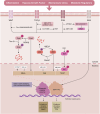Epithelial-mesenchymal transition in colorectal cancer metastasis and progression: molecular mechanisms and therapeutic strategies
- PMID: 40695791
- PMCID: PMC12284022
- DOI: 10.1038/s41420-025-02593-8
Epithelial-mesenchymal transition in colorectal cancer metastasis and progression: molecular mechanisms and therapeutic strategies
Abstract
Colorectal cancer (CRC) continues to be a major contributor to cancer-associated death, with metastatic disease posing substantial therapeutic challenges. The epithelial-mesenchymal transition (EMT) orchestrates the transformation of polarized epithelial cells into motile mesenchymal phenotypes, characterized by enhanced migratory capacity and invasive properties. EMT is central to CRC metastasis and progression, particularly concerning its contribution to invasion, internal infiltration, and colonization. Beyond metastasis, EMT facilitates cancer cells' adaptation to diverse microenvironments, gain of stem cell-like characteristics, metabolic reprogramming, and evasion of therapeutic interventions. EMT signatures are emerging as potential prognostic biomarkers, offering valuable insights for real-time disease surveillance and personalized therapeutic strategies. Targeting EMT presents a promising therapeutic avenue to improve drug sensitivity and counteract resistance in CRC. This review systematically examines the molecular mechanisms regulating EMT in CRC, including key transcription factors; post-translational and epigenetic modifications; non-coding RNAs; and pivotal signaling pathways. Additionally, we evaluate the clinical implications of EMT in CRC progression and metastasis and critically assess emerging therapeutic strategies targeting EMT. This study lays the groundwork for developing more efficient interventions to mitigate metastasis and enhance treatment outcomes and patient survival by elucidating the intricate molecular networks that govern EMT and its contributions to CRC pathology.
© 2025. The Author(s).
Conflict of interest statement
Competing interests: The authors declare no competing interests.
Figures





Similar articles
-
USP6NL knockdown suppresses colorectal cancer progression by inducing CASP9-Mediated apoptosis and disrupting FOXC2/SNAI1-Driven EMT and angiogenesis.Funct Integr Genomics. 2025 Jul 11;25(1):153. doi: 10.1007/s10142-025-01663-5. Funct Integr Genomics. 2025. PMID: 40643716
-
PLIN2 promotes colorectal cancer progression through CD36-mediated epithelial-mesenchymal transition.Cell Death Dis. 2025 Jul 10;16(1):510. doi: 10.1038/s41419-025-07836-1. Cell Death Dis. 2025. PMID: 40640171 Free PMC article.
-
Hippo/YAP signaling pathway in colorectal cancer: regulatory mechanisms and potential drug exploration.Front Oncol. 2025 Jun 19;15:1545952. doi: 10.3389/fonc.2025.1545952. eCollection 2025. Front Oncol. 2025. PMID: 40612350 Free PMC article. Review.
-
Role of Mesenchymal Markers in Colorectal Cancer Metastasis.Mol Biol Rep. 2025 Jul 4;52(1):673. doi: 10.1007/s11033-025-10745-3. Mol Biol Rep. 2025. PMID: 40613936 Review.
-
Molecular drivers of epithelial-mesenchymal transition (EMT) in glioblastoma and impact on therapy resistance.Pathol Res Pract. 2025 Aug;272:156111. doi: 10.1016/j.prp.2025.156111. Epub 2025 Jul 7. Pathol Res Pract. 2025. PMID: 40651122 Review.
References
-
- Patel SG, Dominitz JA. Screening for colorectal cancer. Ann Intern Med. 2024;177:ITC49–64. - PubMed
Publication types
LinkOut - more resources
Full Text Sources

